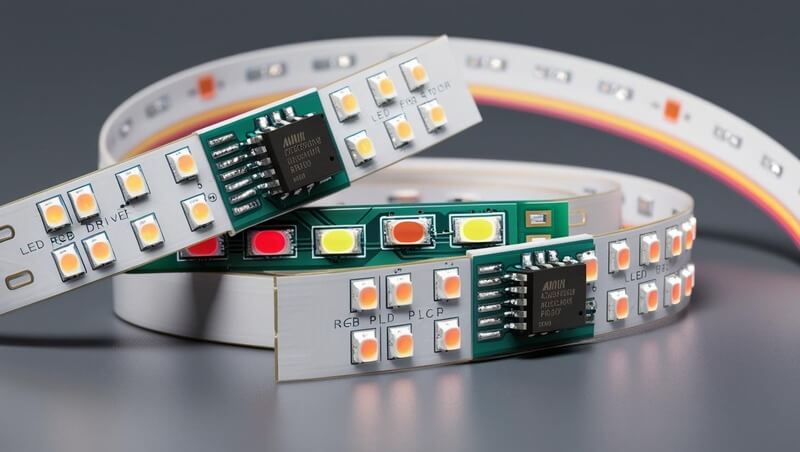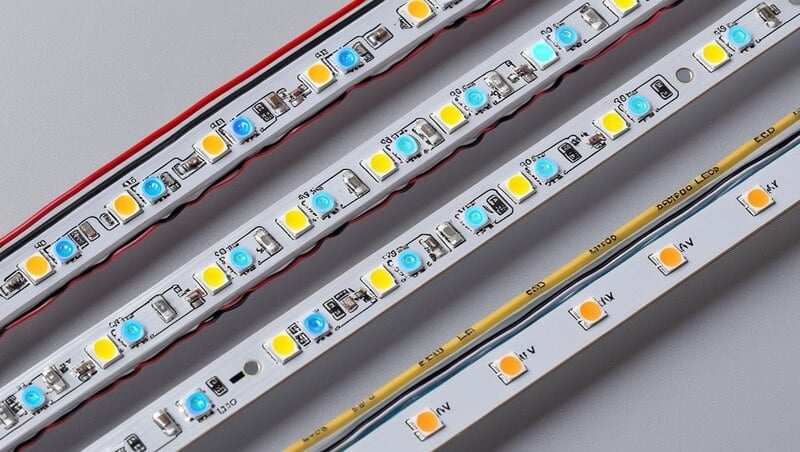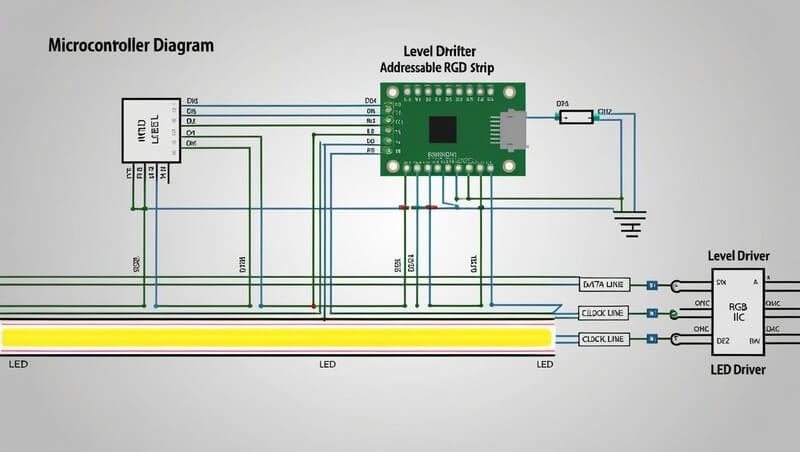

Understanding addressable RGB is essential whether you’re creating dynamic gaming setups or architectural light installations. This guide breaks down the per-LED control mechanism, contrasts addressable with non-addressable RGB, and walks you through wiring and controller requirements.
Addressable RGB means each LED in the strip contains a built-in driver IC that receives serial data, enabling independent color control per pixel. Unlike traditional RGB strips, where all LEDs change together, addressable strips let you program dynamic patterns and animations. Below, I’ll compare addressable vs non-addressable features, show the data-flow diagram, and guide you through wiring and controller setup.

En addressable RGB LED strip embeds a tiny driver IC into each LED package, allowing individual pixels to receive serial data and change color independently. I’ll explain how a single data line (and clock line for APA102) carries color commands downstream: each driver IC reads its specific instruction before passing the remaining data along, creating a daisy-chain effect. This per-LED intelligence unlocks complex animations—rainbows, chases, and gradients—without additional wiring. Unlike standard RGB strips, where all LEDs share the same signal, addressable RGB strips let you program each pixel, offering unparalleled flexibility for dynamic lighting projects.
Key takeaway: Independent pixel control via built-in driver ICs enables rich, programmable lighting effects.

Addressable RGB strips feature built-in driver ICs on each LED, enabling per-pixel control, while non-addressable RGB strips share a common signal for all LEDs, changing colors in unison. Below is a detailed comparison to help you choose the right type for your project.
🧾 T1 — Addressable vs Non-Addressable RGB Comparison
| Feature | Addressable RGB Strip | Non-Addressable RGB Strip |
| Conductors | Power + Ground + Data (± Clock for APA102) | Power + Ground (+ separate R, G, B channels) |
| Control Granularity | Control LED individual | Whole strip uniform control |
| Complexity | Medium–High (requires data wiring & ICs) | Low (simple PWM on color channels) |
| Typical Protocols | Digital serial (WS2812, APA102) | Analog PWM via IR/Wi-Fi controllers |
| Use Cases | Dynamic animations, signage, interactive art | Static color washes, accent lighting |
| Coste | Higher (ICs increase price per metre) | Lower entry cost |
Table T1 provides a clear side-by-side comparison of addressable and non-addressable RGB strip features to guide your selection.

Addressable RGB strips shine in projects where dynamic, pixel-level control adds real impact. Common uses include:
For controller recommendations and project inspiration, visit our case-study gallery or explore LED Strip Controllers & Amplifiers.
Addressable RGB strips enable immersive backlighting, architectural accents, interactive art, and gaming setups with unparalleled pixel-level control.

Addressable RGB strips require a dedicated data connection—and in some protocols, a clock line—from your controller to the first LED driver IC. For WS2812-type strips, you connect the controller’s data-out pin to the strip’s DIN pad; the signal then cascades through each IC, which reads its 24-bit color command before forwarding the remaining data downstream. APA102 strips add a separate clock line, improving timing accuracy for high-speed animations.
Because most microcontrollers (Arduino, Raspberry Pi) operate at 3.3 V logic and WS2812 strips expect 5 V data, you should insert a 330 Ω resistor on the data line and use a 74HCT125 level shifter to prevent signal degradation. Place a 1 000 µF, 6.3 V electrolytic capacitor across the strip’s +5 V and GND rails at the start of the run to smooth voltage spikes. For power distribution, inject 5 V and GND every 1–2 m on long runs to avoid voltage drop; refer to our LED Strip Wiring Guide for detailed schematics.
Key takeaway: Proper level shifting, data-line resistors, decoupling capacitors, and power-injection are essential for reliable addressable RGB performance.
What does “addressable RGB” mean?
Addressable RGB means each LED on the strip has a built-in driver IC that receives serial data, allowing every pixel to change color independently. This per-LED control lets you program complex animations—rainbows, chases, and gradients—without extra wiring, unlike standard RGB strips where all LEDs display the same color.
How do addressable RGB strips receive and interpret data signals?
A single data line (and clock line for APA102) carries 24-bit color commands to each driver IC in sequence. Each IC reads its own instruction—red, green, and blue intensity—then forwards the remaining data downstream. This daisy-chain method enables synchronized, high-speed pixel control across the entire strip.
What controller is required for addressable RGB strips?
You need a controller that outputs compatible digital signals—such as an Arduino with the FastLED library or a dedicated Wi-Fi/USB hub. For WS2812 strips, use a 5 V data pin with a 330 Ω resistor and a level shifter; for APA102, connect separate data and clock pins. Explore our LED Strip Controllers & Amplifiers for ready-to-go options.
What is the difference between RGB and addressable RGB?
Standard RGB strips share common color channels, so all LEDs change together via analog PWM. Addressable RGB strips include a driver IC per LED and use a serial data line—enabling independent pixel control. Addressable strips deliver dynamic effects and animations, while non-addressable strips offer simpler, uniform color changes.
Addressable RGB strips empower you to create stunning, pixel-precise lighting effects—from immersive backlighting and architectural accents to interactive art and dynamic signage. With per-LED driver ICs, serial data control, and proper wiring practices, you can program vibrant animations and transitions that standard RGB strips simply can’t match.
To get started, browse our LED Strip Controllers & Amplifiers collection for compatible hardware, download the detailed LED Strip Wiring Guide, and consult the DOE Solid-State Lighting Fact Sheet 2024 for best practices on power management and longevity.
Key takeaway: Addressable RGB strips offer unmatched flexibility and creative potential when paired with the right controllers and wiring techniques.